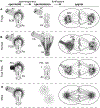It takes two (centrioles) to tango
- PMID: 30496124
- PMCID: PMC6494718
- DOI: 10.1530/REP-18-0350
It takes two (centrioles) to tango
Abstract
Cells that divide during embryo development require precisely two centrioles during interphase and four centrioles during mitosis. This precise number is maintained by allowing each centriole to nucleate only one centriole per cell cycle (i.e. centriole duplication). Yet, how the first cell of the embryo, the zygote, obtains two centrioles has remained a mystery in most mammals and insects. The mystery arose because the female gamete (oocyte) is thought to have no functional centrioles and the male gamete (spermatozoon) is thought to have only one functional centriole, resulting in a zygote with a single centriole. However, recent studies in fruit flies, beetles and mammals, including humans, suggest an alternative explanation: spermatozoa have a typical centriole and an atypical centriole. The sperm typical centriole has a normal structure but distinct protein composition, whereas the sperm atypical centriole is distinct in both. During fertilization, the atypical centriole is released into the zygote, nucleates a new centriole and participates in spindle pole formation. Thus, the spermatozoa's atypical centriole acts as a second centriole in the zygote. Here, we review centriole biology in general and especially in reproduction, we describe the discovery of the spermatozoon atypical centriole, and we provide an updated model for centriole inherence during sexual reproduction. While we focus on humans and other non-rodent mammals, we also provide a broader evolutionary perspective.
Conflict of interest statement
Declarations
The authors declare that they do not have any conflicts of interest.
Figures






References
-
- Artus J, Babinet C & Cohen-Tannoudji M 2006. The cell cycle of early mammalian embryos: lessons from genetic mouse models. Cell Cycle 5 499–502. - PubMed
Publication types
MeSH terms
Grants and funding
LinkOut - more resources
Full Text Sources

